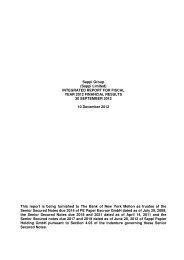2007 Annual Report - Sappi
2007 Annual Report - Sappi
2007 Annual Report - Sappi
Create successful ePaper yourself
Turn your PDF publications into a flip-book with our unique Google optimized e-Paper software.
Notes to the group annual financial statements continued<br />
for the year ended September <strong>2007</strong><br />
2. Accounting policies continued data is applied in measuring the hedge effectiveness of the<br />
profits will be available in future to realise deferred tax assets.<br />
Although the deferred tax assets which have been recognised<br />
are considered realisable, actual amounts could be reduced if<br />
financial instrument. Hedge ineffectiveness is recognised<br />
immediately against income. The group does not currently have<br />
any cash flow hedges.<br />
future taxable income is not achieved. This can materially affect<br />
our reported net income and financial position.<br />
<strong>Sappi</strong> released a US$6 million provision in the fourth quarter of<br />
Refer to note 31.5 of the Group <strong>Annual</strong> Financial Statements<br />
contained elsewhere in this <strong>Annual</strong> <strong>Report</strong> for details of the fair<br />
value hedging relationships.<br />
fiscal <strong>2007</strong> as a result of South African income tax legislation<br />
which was, in management’s opinion, substantively enacted at<br />
year end. If the legislation had not been substantively enacted<br />
The group has the following fair value hedges which qualify for<br />
hedge accounting:<br />
a further provision of US$11 million would have had to be raised<br />
Bonds at fixed interest rates with a total principle amount of<br />
in fiscal <strong>2007</strong>.<br />
US$856 million are hedged by seven external interest rate<br />
Hedge accounting for financial instruments<br />
swaps (IRS), with a negative fair value of US$23 million which<br />
convert the US$ fixed interest rates into floating 6-month LIBOR<br />
For the purposes of hedge accounting, we classify hedges into<br />
in arrears. The nature and the amounts involved in the hedging<br />
two categories: (a) fair value hedges which hedge the exposure<br />
relationship has not changed in the current year.<br />
to changes in the fair value of a recognised asset or liability; and<br />
(b) cash flow hedges, which hedge exposure to variability in cash<br />
In fiscal 2005 the hedge was de-designated at the end of March<br />
flows that are either attributable to a particular risk associated<br />
2005 and was only re-designated three months later. During<br />
with a recognised asset or liability or a forecasted transaction.<br />
this period hedge accounting was interrupted. The changes in<br />
The financial instruments that are used in hedging transactions<br />
fair value of the bonds until the moment of de-designation are<br />
are assessed both at inception and quarterly thereafter to ensure<br />
amortised over the remaining life of the hedge.<br />
they are effective in offsetting changes in either the fair value<br />
or cash flows of the related underlying exposures. Hedge<br />
accounting is mainly used for debt instruments to hedge interest<br />
The following is an analysis of the impact on pre-tax profit or<br />
loss from the period:<br />
rate and foreign currency risk exposures and for firm<br />
commitments to hedge foreign currency risk exposures. We do US$ million <strong>2007</strong> 2006<br />
not currently use hedge accounting for trading transactions.<br />
De/re designation – –<br />
In relation to fair value hedges, which meet the conditions for Amortisation (2) (2)<br />
hedge accounting, any gain or loss from re-measuring the Residual ineffectiveness – 4<br />
hedging instrument to fair value is recognised immediately<br />
against income. Any gain or loss on the hedged item<br />
(2) 2<br />
attributable to the hedged risk is adjusted against the carrying<br />
amount of the hedged item and recognised against income.<br />
Any residual ineffectiveness related to fair value hedges affects<br />
our reported net income. External market data is applied in<br />
re-measuring the hedging financial instrument.<br />
During <strong>2007</strong>, <strong>Sappi</strong>’s firm commitments for the purchase of<br />
equipment in foreign currency were hedged for foreign<br />
exchange risk by forward exchange contracts and were<br />
designated as a fair value hedge. The value of the outstanding<br />
firm commitments hedge accounted for was EUR31.4 million<br />
(2006: EUR15.4 million) and US$2.7 million (2006: US$1.1 million).<br />
In relation to cash flow hedges, which meet the conditions<br />
for hedge accounting, the portion of the gain or loss on the<br />
hedging instrument that is determined to be an effective hedge<br />
is recognised directly in shareholders’ equity and the ineffective<br />
These foreign currency forward exchange contracts had a<br />
negative fair value of US$0.3 million. Since the critical terms<br />
perfectly match, there was no residual ineffectiveness affecting<br />
profit and loss for the period.<br />
portion is recognised in income. The gains or losses, which are<br />
recognised directly in shareholders’ equity, are transferred to<br />
income in the same period in which the hedged transaction<br />
affects income. Any residual ineffectiveness related to cash flow<br />
hedges can affect our reported net income. External market<br />
Plantations<br />
We state our plantations at their fair value, less estimated costs<br />
to sell at the harvesting stage. The fair value of immature timber<br />
is the present value of the expected future cashflows taking<br />
88<br />
sappi limited | 07 | annual report
















